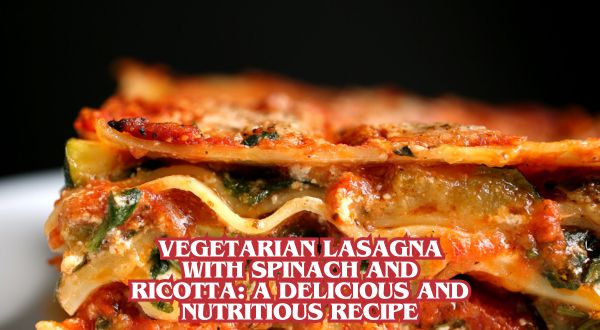Vegetarian Lasagna with Spinach and Ricotta: A Delicious and Nutritious Recipe
Vegetarian lasagna made spinach ricotta is a delightful and wholesome dish that can be eaten at any time of the day. Not only is this version filled with nutrients, but it is also incredibly tasty which is why it appeals to both vegetarians and non vegetarians. Stacked with fresh spinach, creamy ricotta cheese and pasta layers, this meal provides an excellent way for someone to have meatless dinnertime without feeling hungry.
Lasagna has been enjoyed by many people over the centuries as a traditional Italian dish. It typically consists of layers of pasta, meat sauce, and cheese. However, vegetarian lasagna with spinach and ricotta offers a lighter and healthier alternative without sacrificing any of the taste. This vegetarian version is perfect for those looking to reduce their meat intake or simply enjoy a delicious, meat-free meal.
Ingredients: Vegetarian Lasagna with Spinach and Ricotta
The ingredients that will be required for preparing vegetarian spinach lasagna are:
- 12 pieces of lasagna sheets
- Two tablespoons olive oil
- One medium sized onion finely chopped
- Four cloves garlic minced
- Two cans (28 ounces each) crushed tomatoes
- One teaspoon dried basil
- One teaspoon dried oregano
- Salt and pepper to taste.
- 2 cups ricotta cheese.
- 1 large egg.
- 4 cups fresh baby spinach (chopped).
- Three cups shredded mozzarella cheese.
- One cup grated Parmesan cheese.
- -Fresh basil leaves for garnish (optional)

Preparation
Cook the Lasagna Noodles: First cook the lasagna noodles following package instructions; then drain them when they are al dente stage and put aside ensuring they don’t stick together. Prepare the Sauce: In a large skillet heat up the olive oil over medium heat. Add chopped onion and cook until it becomes translucent which should take about 5 minutes. And then add the minced garlic and cook for another minute until it becomes fragrant. Combine crushed tomatoes, dried basil, dried oregano, salt and pepper in a skillet; allow sauce to simmer for about 20 minutes so that flavors can blend together. Prepare the Ricotta Mixture: While the sauce is cooking, combine ricotta cheese in a large bowl with an egg and chopped spinach. Mix them all together well. Egg will bind mixture together while spinach will give color and nutrients to lasagna.
Assembling the Lasagna
Preheat the Oven: Preheat your oven to 375°F (190°C) so that your lasagna doesn’t stick. Layering the Lasagna: Spread a thin layer of tomato sauce on the bottom of the baking dish. Place three lasagna noodles over this first layer of sauce. Spread one-third of the ricotta mixture over it. Sprinkle one cup shredded mozzarella cheese on top of ricotta mixture. Add more tomato sauce again until you get to top where you spread grated Parmesan cheese on it as toppings before baking at 180 degrees until done.
Bake it: Cover the baking dish with aluminum foil and bake for 30 minutes in a preheated oven. After half an hour, discard the foil and continue baking until the cheese on top melts and bubbles.
Let it Sit: Once you remove your lasagna from the oven, give it about 10 minutes to sit down. This makes solidify the layers so that you can cut through them delicately.
Serving Suggestions
Spinach and ricotta vegetarian lasagna can be served on its own or along with an array of other accompaniments like these:
Garlic Bread: A side of hot garlic bread is a traditional accompaniment for lasagna. The crunchy bread soaked in butter becomes ideal for mopping up any excess sauce.
Green Salad: To offset the richness of Lasagna, consider serving it with a simple green salad dressed lightly with vinaigrette dressing. The addition of cherry tomatoes will add more color and bite when combined with cucumbers and bell peppers.
Roasted Vegetables: Some roasted vegetables such as zucchini, bell peppers and carrots would go well as your lasagna’s side dish. They are sweetened by roasting which also provides an interesting contrast to lasagna flavors.
Wine: Chianti or robust Merlot are great red wines that pair well with Lasagna if you enjoy wine.
Tips for Making the Perfect Vegetarian Lasagna with Spinach and Ricotta
Use Fresh Ingredients: To enhance the taste of your lasagna, opt for fresh spinach and good quality ricotta cheese whenever possible instead of using frozen ones which may lack flavor or texture because they have been thawed out before being included in this recipe.
Season Well: Each layer of your lasagna has to be seasoned properly with salt plus pepper so that individual components become tastier thus making a flavorful dish.
Let it Rest: It is very important to let your lasagna rest after baking. This will give the layers time to set, and make it easier to cut and serve without falling apart.
Experiment with Vegetables: Although spinach is the most common vegetable used in vegetarian lasagna, you can try other vegetables too. For instance, sautéed mushrooms, zucchini or eggplant can add great textures and flavors to your lasagna.
Nutritional Benefits
Vegetarian lasagna with spinach and ricotta is not only delicious but also packed with nutrients. Below are some of the nutritional benefits of this recipe:
Spinach: Spinach is a good source of vitamins A, C & K as well as calcium & iron. This is an excellent way of boosting the nutritional value of your lasagna.
Ricotta Cheese: Ricotta cheese is high in protein and calcium making it a healthy addition for any meal. Additionally, it gives a creaminess that compliments well with others taste buds.
Tomatoes: The tomato sauce used in this dish carries much vitamin A plus C as well as lycopene which is linked with several health advantages.
Whole Grains: You should also choose whole grain noodles because they have got much fiber that aids digestion if you want to avoid constipation.
Alternatives
There are many different ways that you can make a vegetarian lasagna with spinach and ricotta to match your tastes or dietary needs. Here are some variations to consider.
Gluten-Free: Instead of regular lasagna sheets, use those that are gluten-free in order to accommodate those who might have special dietary restrictions like celiac disease or gluten allergy.
Vegan: Rather than using mozzarella cheese and ricotta, replace them with vegan versions. You can get vegan cheeses at most major grocery stores or prepare from home using tofu or nuts.
Low-Carb: To create a low-carb version, substitute the lasagna noodles for thin slices of eggplant or zucchini.
More Vegetables: If you want more nutrients and flavors in your lasagna, add more vegetables. Baked bell peppers, mushrooms or carrots could be some added ones worth considering.
Storage and Reheating
You can make vegetarian spinach ricotta lasagna ahead of time and keep it for later use. Follow this guide on how to save and reheat your lasagna:
Refrigeration: In an airtight container, refrigerate any remaining amount of the lasagna for up to 4 days.
Freezing: Completely cool the lasagna before wrapping it tightly with plastic cling film then aluminum foil if you wish to freeze it The freezer life is 3 months.
Reheating: For reheating refrigerated lasagna, put it into a baking dish, cover with foil and bake at 350°F (175°C) until heated through about twenty to thirty minutes. Thaw frozen lasagnas over night in refrigerator before reheating.
Conclusion
Vegetarian Lasagna with Spinach & Ricotta combines traditional richness of normal Lasagna with the health benefits of being veggie. It’s quick-to-make yet delicious: packed full of nutrients. Whether you are vegetarian or simply want to have a meat-free meal, this Lasagna will satisfy your taste buds. Serve it with your favorite sides, experiment with different vegetables, and enjoy the wonderful flavors and textures of this classic Italian dish.
Classic Spaghetti Bolognese Recipe: A Timeless Favorite








